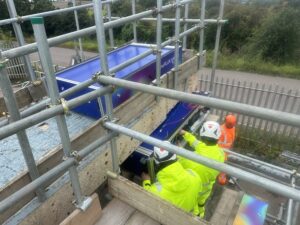Air pollution levels in Oxford have decreased by 14% on average, compared with a 9% average reduction across the UK.
Data from Oxford City Council has found that during 2023, overall NO2 levels in Oxford decreased by 14% on average on 2022 levels, and 33% on pre-pandemic (2019) levels.
The data also indicates that, for the first time outside of the coronavirus pandemic (2020), Oxford was in compliance with the UK’s legal limit for NO2 in all areas of ‘relevant exposure’ within the city. These areas include places where the public is likely to spend time regularly, such as residential areas, the city centre, and areas with pedestrians.
The data follows the publication of Oxford City Council’s latest Air Quality Annual Status Report for 2023, which examines air pollution levels across 128 locations in the city from January 2023 – December 2023.
Some of the highlights of the latest report are:
- Overall NO2 levels across the city decreased by 14% on average compared with 2022 levels. This is also higher than the 9% average reduction across the UK during 2023
- NO2 levels across Oxford are now (on average) 33% below 2019 levels, and 18% since the Council launched its latest Air Quality Action Plan (AQAP) in 2021
- 126 out of 128 sites were compliant with the UKs legal target for air pollution – the first time outside of the coronavirus pandemic which saw a 59% decrease in air pollution levels.
- Only two sites were found to be in breach of the UK’s legal target. Both are located in areas with limited public exposure to air pollution (busy roads away from residential areas or areas with pedestrians):
- Headington Hill measured a concentration of 53 µg/m3. While still 32% (13 µg/m3) over the legal target, this is a 24% reduction compared to in NO2 levels in 2022 (70 µg/m3).
- Southern Bypass – south of Botley Interchange measured a concentration of 42 µg/m3. (Note: this location is being managed by Vale of the White Horse District Council as part of their Air Quality Action Plan)
- Nine sites were higher than Oxford’s own local annual mean target for NO2: St Aldates (32 µg/m3) St Clements (38 µg/m3 and 34 µg/m3), High Street (31 µg/m3), Holloway Road (31 µg/m3), Headington Hill (53 µg/m3), and Oxford’s ring road (32 µg/m3, 34 µg/m3, 42 µg/m3). For comparison, 18 locations were in breach of this target in 2022.
- Air pollution levels reduced in every monitoring location both inside and outside the Low Traffic Neighbourhoods and Zero Emission Zone (ZEZ) Pilot.
ZEZ Pilot
In February 2022, the Oxfordshire County Council and Oxford City Council launched the UK’s first Zero Emission Zone (ZEZ) pilot in Oxford.
- NO2 levels have continued to reduce overall within the ZEZ Pilot area, and are all below the legal limit, and local air pollution target
- New Inn Hall St, Cornmarket St and Bonn Square all saw reductions of 2 µg/m3 (or 13%, 11% and 9%)
- St Michaels Street and Queen Street reductions of 1 µg/m3 (7% and 5%)
- George Street (Magdalen Street), which is a boundary road to the ZEZ Pilot, saw a slight increase of 2 µg/m3 (or 9%)
Low Traffic Neighbourhoods (LTNs)
- All the monitoring locations both inside and on the boundary roads of Oxford’s LTNS showed a decrease in NO2 levels measured in 2023, compared to 2022.
- None of the NO2 levels measured both inside and on the boundary roads of Oxford’s LTNS were above the UK legal limit.
- On the boundary roads, only three monitoring locations saw NO2 levels above the city’s own NO2 target: St Clement’s (38 µg/m3 and 34 µg/m3), and Holloway Road (31 µg/m3)
Particulate pollution (PM2.5 and PM10)
- PM10 levels have decreased at monitoring sites, with the values at urban background and roadside sites being 9 µg/m3 and 14 µg/m3 respectively, both below the UK legal limit.
- 5 levels were 6 µg/m3 at the urban background site and 8 µg/m3 at the roadside site. The roadside site’s level slightly exceeds the WHO recommended annual mean.
Botley road closure
From April 2023, Botley Road was closed to traffic due to the wider improvements to the western side of Oxford Railway station.
NO2 levels are measured at four different locations along Botley Road. While the road was open in 2022, the average NO2 level measured at these locations was 19 µg/m3.
During 2023, the average NO2 level dropped by 17% to 15.8 µg/m3.
PIC-.GOV.UK























